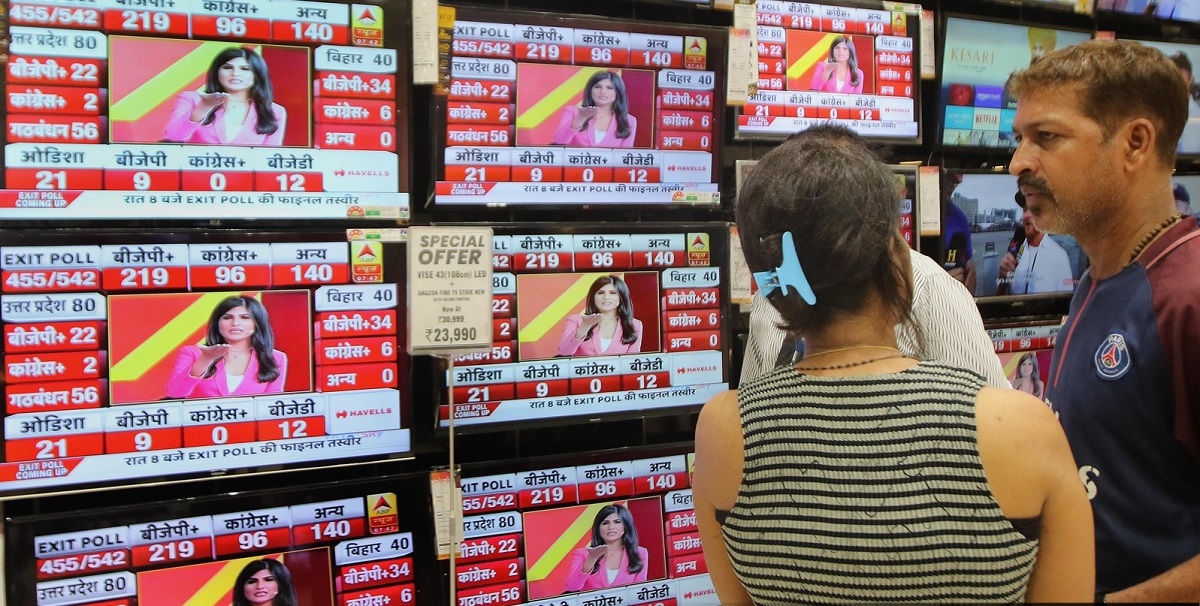In the intricate landscape of Indian democracy, elections are a captivating spectacle, scrutinized closely by voters, politicians, and analysts alike. Exit polls, conducted immediately after voters leave the polling stations, aim to predict the outcome before the official results are announced. However, these polls frequently fall short of accuracy and often seem biased in favour of the ruling party. This recurring discrepancy raises significant questions about the reliability and impartiality of exit polls in India.
A primary challenge in conducting accurate exit polls in India is the country’s vast and diverse electorate. With over a billion people from numerous castes, religions, languages, and regional identities, it is immensely difficult to capture a representative sample that accurately reflects the entire population’s voting behaviour. This complexity often results in skewed samples and inaccurate predictions.
Exit polls in India face several methodological challenges. Pollsters must ensure that their sample of respondents is truly representative, balancing factors like urban-rural divides, literacy levels, and socio-economic statuses. Logistical issues such as accessing remote areas and ensuring the safety of pollsters can also introduce biases in data collection, further distorting the results.
Indian voters often exhibit reluctance in revealing their true voting preferences, a phenomenon known as the “shy voter” effect. Cultural norms, fear of political retribution, or a desire to maintain privacy can lead voters to provide false or misleading information to pollsters. This tendency significantly distorts the data collected during exit polls.
The strategic nature of voting in India complicates the accuracy of exit polls. Voters may change their preferences at the last minute based on various factors, including candidate performance, local developments, or last-minute campaign efforts. Additionally, tactical voting—where voters choose a candidate not because they prefer them, but to prevent another candidate from winning—can further complicate predictions. Exit polls, conducted immediately after voting, may not fully capture these dynamics.
The historical performance of political parties and media influence can impact the reliability of exit polls. Media narratives and pre-poll surveys can create biases, influencing voters’ responses during exit polls. Exit pollsters may also be subconsciously influenced by historical trends, leading to biased predictions that favour the ruling party. This bias can create self-fulfilling prophecies, further eroding the accuracy of exit polls.
Let’s examine some notable examples where Indian exit polls failed to match the actual election results:
- 2004 General Elections: This election stands as one of the most prominent examples of exit poll failure. Most exit polls predicted a comfortable victory for the incumbent BJP-led NDA. However, the Congress-led UPA emerged victorious, securing 218 seats compared to the NDA’s 181. This unexpected outcome highlighted the limitations and biases of exit polls.
- 2. 2015 Bihar Assembly Elections: Exit polls were split, with some predicting a win for the BJP and its allies, while others foresaw a victory for the Grand Alliance (RJD, JD(U), and Congress). The actual results showed a decisive win for the Grand Alliance, which secured 178 out of 243 seats, contrary to many predictions.
- 3. 2017 Uttar Pradesh Assembly Elections: While most exit polls predicted a BJP victory, the extent of the win was grossly underestimated. The BJP won 312 out of 403 seats, a significantly higher number than what most exit polls had suggested.
- 2019 General Elections: Despite most exit polls predicting a BJP-led NDA victory, the actual results showed an even more decisive win, with the NDA securing 353 seats. The magnitude of the BJP’s victory was again underestimated by many exit polls.
- 5. West Bengal Assembly Elections 2021: Many exit polls predicted a close contest between the BJP and the ruling TMC. However, the final results showed a sweeping victory for the TMC, which secured 213 out of 294 seats, while the BJP managed only 77 seats. The exit polls failed to capture the TMC’s strong hold on the state.
- Delhi Assembly Elections 2015 and 2020: In 2015, most exit polls underestimated the Aam Aadmi Party (AAP)’s performance, predicting a hung assembly or a slim majority. The AAP ended up winning 67 out of 70 seats. Similarly, in 2020, exit polls predicted a win for AAP, but the actual results were even more lopsided, with AAP winning 62 out of 70 seats, far exceeding the predictions.
The frequent failure of Indian exit polls to predict actual election results highlights the inherent challenges in capturing the voting behaviour of such a diverse and complex electorate. Methodological flaws, voter reluctance, strategic voting, and media biases all contribute to the inaccuracies, often skewing results in favour of the ruling party. As India continues to evolve, so too must the methods used to understand its electorate. Until then, exit polls will remain an intriguing, albeit unreliable, part of the electoral landscape.
Nadeem Khan is a Social Activist associated with Spect Foundation
